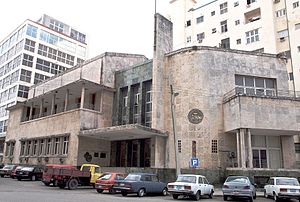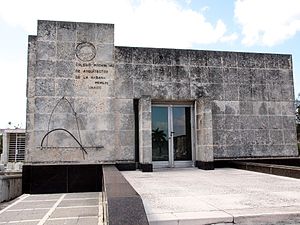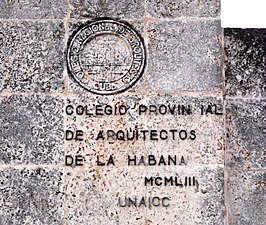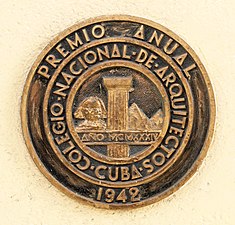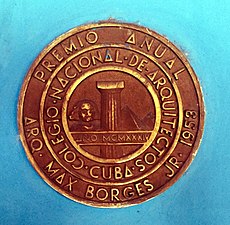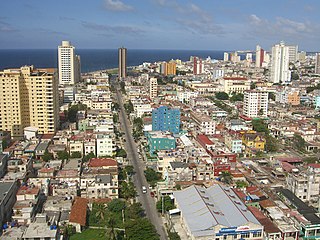
Havana is the capital and largest city of Cuba. The heart of the La Habana Province, Havana is the country's main port and commercial center. It is the most populous city, the largest by area, and the second largest metropolitan area in the Caribbean region. The population in 2002 was 2,137,847 inhabitants, and its area is 728.26 km2 (281.18 sq mi) for the capital city side and 8,475.57 km2 for the metropolitan zone.

El Tropicana Night Club in Havana, Cuba located in a lush, 36,000-square-metre (390,000 sq ft) estate tropical garden opened on December 30, 1939 at the Villa Mina in Marianao. It is located next door to the old Colegio de Belén, Havana, presently, the Instituto Técnico Militar.

Vedado is a central business district and urban neighborhood in the city of Havana, Cuba. Bordered on the east by Calzada de Infanta and Central Havana, and on the west by the Alemendares River and Miramar / Playa district, Vedado is a more modern part of the city than the areas to the east, developed in the first half of the 20th century, during the Republic period. In 2016 it was described by one commentator as the city's "most affluent" section. The main street running east to west is Calle 23, also known as "La Rampa". The northern edge of the district is the waterfront seawall known as the Malecón, a famous and popular place for social gatherings in the city. The area popularly referred to as 'Vedado' consists of the wards of Vedado, Rampa, Vedado-Malecón and Carmelo, all in the municipality of Plaza de la Revolución.
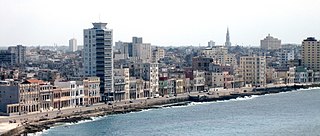
The Malecón is a broad esplanade, roadway, and seawall that stretches for 8 km along the coast in Havana, Cuba, from the mouth of Havana Harbor in Old Havana, along the north side of the Centro Habana neighborhood and the Vedado neighborhood, ending at the mouth of the Almendares.
Max Borges Jr., born Max Borges Recio, was a Cuban architect best known for his work in Havana in the 1940s and 1950s. He later moved to the United States.
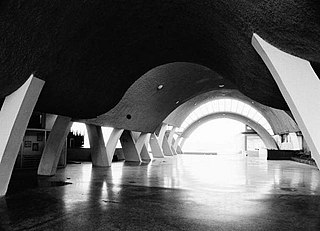
Club Náutico is a building in Cuba. It is in the reparto of Náutico, Playa, Havana.

Leonardo Morales y Pedroso was one of the most prominent Cuban architect in Cuba in the first half 20th century. In 1900 he entered and attended pre-university studies at De Witt Clinton High of New York, where he obtained a bachelor's degree. In 1909 he graduated of Bachelor in Architecture from Columbia University. After graduating, he returned to Cuba in 1909 where he worked a time in the local architect firm of Newton & Sola with the architect Thomas M. Newton, who was director of the civil construction section of the Secretary of Public Works during the 2nd American intervention in Cuba. In February 1910, he returned to the United States and obtained a master's degree (Doctor) in Architecture from Columbia University in the State of New York. After obtaining his doctorate in architecture he joined in March 1910 the architecture Company Morales y Mata arquitectos, created in 1907 by his elder brother the engineer Luis Morales y Pedroso in association with the master builder Jose F. Mata. In 1917, after having built more than 30 important buildings, they decided to separate from José Mata, who had to stop working because illness and died a short time later. The company changed its name for Morales y Compañia Arquitectos with his brother the engineer Luis Morales y Pedroso as president and Leonardo as Associate together with other 7 architects. He was able to obtain noteworthy real estate commissions partly because of his family's origin, good social connections and social standing in Havana high society. He was named by the Cuban press of the time as the "Havana's architect" and his architectural style is recognized as the "Morales style". During 50 years Leonardo Morales y Pedroso received around 250 notable architectural commissions, some of them include:

La Rampa is a main street in the Vedado district of Havana, Cuba. La Rampa runs from Calle L to the Malecón. Built in 1930, the end was the location of the Battery of Santa Clara that protected the city from attack.

The FOCSA Building is a residential and commercial block in the Vedado neighborhood of Havana, Cuba. At 121 meters (397 ft), it is the tallest building in Cuba. It was named after the contracting company Fomento de Obras y Construcciones, Sociedad Anónima, and the architects were Ernesto Gómez Sampera (1921–2004), Mercedes Diaz, and Martín Domínguez Esteban (1897-1970), who was the architect of the Radiocentro CMQ Building. The structural engineer was Luis Sáenz Duplace, of the firm Sáenz, Cancio & Martín, and professor of engineering at the University of Havana. The civil engineers were Bartolome Bestard and Manuel Padron. Gustavo Becquer and Fernando H.Meneses were the mechanical and electrical engineers, respectively. It is located on a site bordered by Calles 17 and M and Calles 19 and N in the Vedado.
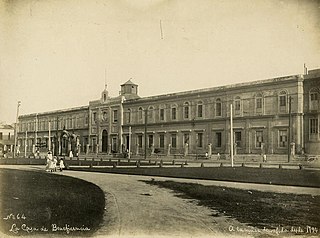
La Casa de Beneficencia y Maternidad de La Habana, was for 270 years Havana's repository of Havana's unwanted children. The House of Charity started during a time when Cuba was experiencing extreme poverty, unemployment, and corruption in the government. Corrupt leaders were plundering the public treasury and little attention was given to social assistance, health, education, or the protection of the poor: "los desamparados".

The López Serrano Building was the tallest residential building in Cuba until the construction of the FOCSA in 1956. Designed by the architect Ricardo Mira in 1929, who in 1941 who also designed La Moderna Poesia bookstore on Obispo Street for the same owner, it is often compared to the Bacardi Building in Old Havana built two years before the López Serrano Building because of their similarity in massing and central tower. The congressman, senator, and presidential candidate Eduardo Chibás was living on the fourteenth-floor penthouse when he committed suicide in August 1951 on the air at CMQ Radio Station.

The Iglesia del Espíritu Santo is a colonial church at #702 Calle Cuba in Old Havana, Havana, Cuba, was built in 1635 on the corner of the corner of Calles Cuba and Acosta. The Espíritu Santo contains some notable paintings including a seated, post-crucifixion Christ on the right wall, and catacombs. It is considered one of the oldest temples in Havana. Free blacks, already numerous, devoted the church to the Holy Spirit in 1638.

The Radiocentro CMQ Building complex is a former radio and television production facility and office building at the intersection of Calle L and La Rampa in El Vedado, Cuba. It was modeled after Raymond Hood's 1933 Rockefeller Center in New York City. With 1,650 seats, the theater first opened on December 23, 1947, under the name Teatro Warner Radiocentro, it was owned by brothers Goar and Abel Mestre. Today the building serves as the headquarters of the Cuban Institute of Radio and Television (ICRT).

The Edificio del Seguro Médico is a commercial building in El Vedado, Havana. Built between 1955 and 1958, it was designed as a mixed use building for apartments and offices for the headquarters of the National Medical Insurance Company by Antonio Quintana Simonetti.

Hospital de San Lázaro was a hospital in the city of Havana, Cuba. It dates back to the 17th century, when it served as headquarters for some huts built near the Caleta de Juan Guillén, then known as Caleta de San Lázaro, in an area about a mile outside the city walls.
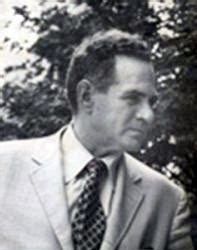
Mario Romañach (1917–1984) was a Cuban modernist architect, planner, and university professor.
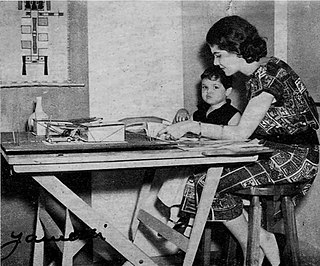
Matilde Ponce Copado (1932-2001) was a Cuban modernist architect.

The Colegio de Belén located between 45th and 66th streets, situated next door to the Tropicana nightclub, in Marianao, Havana, was designed in 1925 by the architect Leonardo Morales y Pedroso and his brother the engineer Luis Morales y Pedroso of the firm Morales y Compañía Arquitectos.
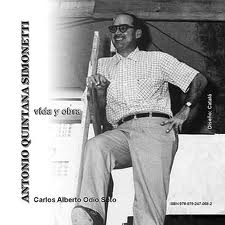
Antonio Luis Quintana Simonetti was a Cuban architect and a forerunner of Modern architecture in Havana. Quintana graduated from the University of Havana in 1944, among his works are some of the most important modernist buildings in the capital. Dissatisfied as a student with the classical canons, Antonio Quintana participated in 1944 in the so-called "Burning of Vignola" in the courtyard of the School of Architecture of the University of Havana. From this date forward, he began to study the precepts of contemporary architecture. He graduated as an architect in the same year.

